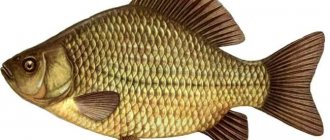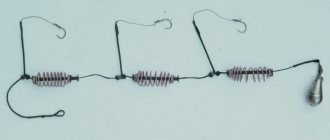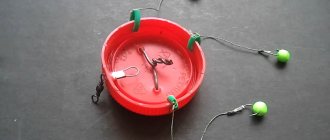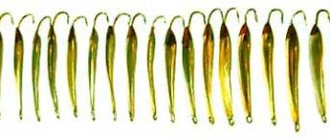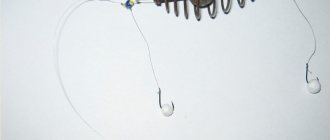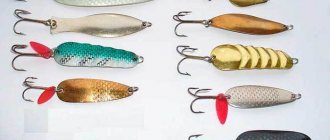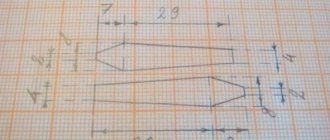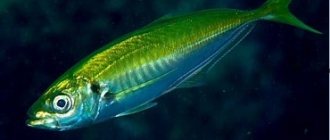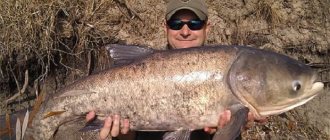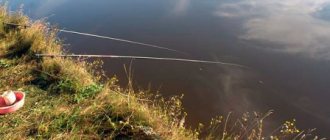- What does a nipple for fishing for white fish look like?
- Nipple fishing: gear
- Donkey rod
- Which reel is suitable
- Line, leashes, hooks
- Pea and semolina porridge
- Millet porridge
- Wheat-corn porridge
A fishing nipple is not a very sporting tackle, but with its help it is very effective in catching various types of peaceful fish.
The larger its size, the smarter it is, and no wonder, because it is not easy to reach such a size in a body of water where danger awaits at every step. A nipple, also known as a smoktukha, is a bottom equipment that has common features with a feeder. There are many different designs, but the scheme of operation is the same - a feeder and short leashes. Smoktukha is often compared to a “crucian carp killer,” but it is much easier to make.
What is a pacifier?
The nipple is a bottom tackle. It is suitable for catching large specimens and is a direct competitor to the feeder. The essence of the work of this gear is to fill a special feeder with complementary foods and the presence of several hooks fixed on leashes. You can make a pacifier yourself or purchase a ready-made model in a specialized store.
Types of nipples
The most popular among fishermen are two types of nipples:
- Spring type. This option is a regular spring of various sizes. The method of attaching a nipple to a fishing line with a spring has two variations. Blind fastening is tying the main fishing line and leads directly to the spring. To ensure sliding of a spring-type teat, a small tube is attached along the central axis of the feeder. On the working line, the spring stroke is stabilized with the help of beads or rubber stoppers. To make a spring, it is preferable to use wire made of non-ferrous metal. This will simplify the work process and avoid rust on the spring.
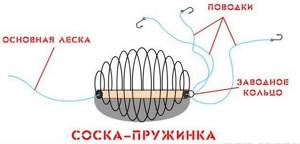
- Pacifier plug. A popular option for cork is to make it from a bottle cap. Making such a system will require some modification to the plastic bottle cap. The bottom should be weighted with lead filler, which will ensure uniform lowering of the equipment and prevent it from moving downstream. You should also drill several holes on the sides of the plug to fix the main fishing line and leads. The popularity of cork nipples is due to the features of the shape, which is optimally suitable for filling with complementary foods.
Gear design and its varieties
Experienced fishermen know that there are a great variety of nipples.
True, the principle of operation they do not differ from each other. The tackle consists of a feeder, a couple of leashes and is used only at the bottom. Plug nipple and spring nipple are the most popular options that anglers pay attention to. Below we will describe in detail both one option and the other.
Spring nipple
This product is a tackle where the role of a feeder is played by a spiral or spring made of metal. There is a weight inside the element. It is the part to which the fishing line, leashes and hooks are attached. If fishing with a nipple is carried out at shallow depths, then it is permissible not to use a weight.
In this case, some fishermen use a “donut”, which is a spring and has the shape of a steering wheel, and leashes with hooks are attached to it. Fish treats are placed in the center of the donut where the hooks are. Thus, tasting something tasty, the fish gets hooked.
Pacifier plug
Equipment in the form of a cork appeared not so long ago. It consists of a plastic bottle (citro or yogurt), and a lead disk is attached to its upper part using a bolt, nut or wire.
In addition, there are also a couple of holes on the side circumference, where through one the feeder is attached to the main fishing line, and on the others there are leashes with hooks. As for filling the feed, everything happens in the same way as in the previous case. The treat is in the middle of the feeder, where there are hidden hooks. Sometimes fishermen boast that self-hooking happens. This doesn't happen often, but it does happen.
The essence of the nipple fishing method
As a rule, carp, crucian carp and representatives of these species are caught using the nipple. It is also quite possible to catch rudd, carp, grass carp, and roach.
The essence of fishing using a nipple is to choose the right place and secure the bait well. Its manufacture and fixation require knowledge of certain tricks.
For example, the bait should be soaked until it reaches the consistency of a viscous dough. This will allow the food to be securely secured in the body of the plug. First, you need to select a place for fishing, install stands and alarms. After filling the nipple with complementary foods, throw the bait into the pond and wait for a bite.
Additional equipment of hooks with foam balls or worms in combination with aromatic bait will attract fish. Fishing using the gear in question can take place both on a lake, an artificial reservoir, and on rivers. But, in the latter case, the speed of the current should be taken into account, which may require additional weighting of the gear.
How to make a cork for crucian carp with your own hands
With cork
To make a nipple plug you will need the following items:
- plastic bottle cap;
- a piece of lead, a washer or nut of a suitable size;
- a short piece of thin wire;
- a nail or drill that matches the thickness of the wire;
- winding ring.
The challenge is to make the sinker round and attach it to the top of the cork. Lead and cork are applied to each other, after which you need to make 2 holes using a drill or nail. The wire is threaded through these holes and will later be used as fasteners.
With spring
Spring tackles are divided into 4 types:
- loaded deaf;
- loaded sliding;
- unenlightened deaf;
- unloaded sliding ones.
A weighted nipple rig is a heavy spring that can be easily cast long distances without the need for additional weights. An unweighted rig is a light spring that is used in combination with a sinker. The blind feeder-nipple is tied to the main fishing line directly or through a carabiner.
To make a weight, any lead or metal element that weighs about 30 g is suitable. If the fishing takes place in the current, then a heavier weight (up to 100 g) may be needed. The size of the weight must match the size of the lid with food so that it fits correctly on the bottom.
Leashes
To make leashes, it is recommended to use strong fishing line with a diameter of at least 0.4 mm. A thin fishing line can quickly deteriorate and break, as it will constantly rub against underwater rocks, shells, reeds, etc. If sliding equipment is used, the length of the leash should be at least 50 cm. The most suitable length for a blind nipple is 20 cm.
The leash should be thinner than the main line, because if you hook or bite a fish that is too large, you will not lose all the equipment, but only the hook with the leash. It is recommended to replace the main line with a stronger braided thread.
Hooks
Hooks with a spring or a plug should be selected depending on what kind of fish you are going to catch. The larger the fish, the larger the hook will be needed. In most cases, numbers from 5 to 10 are used. It must be borne in mind that a small specimen will not be able to swallow a large hook, and a large fish can break it if it is too small.
When fishing with a nipple, the number of leashes depends on individual preferences, but equipment with 2-3 hooks is considered the most effective. If the leashes are long, you will need carabiners that will prevent them from twisting.
In the case of a sliding spring, you will need a rubber or plastic tube to mount the gear. Beads or pieces of rubber are used as stoppers to limit the movement of the feeder. It is recommended to install a carabiner between the spring and the main fishing line (braid), which will allow you to quickly replace the equipment if necessary.
We invite you to familiarize yourself with: Donka for pike perch, selection and installation of gear, fishing features
Many fishermen want to know how to make a nipple. The reason for this is that the tackle is simple, convenient, and does not require any special knowledge in fishing. In addition, in general, in terms of money, if you do it yourself, it will not be expensive.
To make it you will need to stock up on the following parts:
- A traffic jam.
- Nails or drill.
- Scissors that cut metal.
- Wire (medium wire will do).
- A sheet of lead or a metal coin.
- Winding ring.
Next, you will need to use scissors to cut out a round weight, which is the same size as the size of the cork. If sheet lead is not found for this purpose, then a metal washer will also work. After this, two holes should be made in the cargo, as well as in the cork, using a drill or nail. Next, you will need to attach the load with wire.
It is important to ensure that the twist is inside the cork. Then you need to make a couple of holes in the side circumference of the cork. Place the winding ring in one and attach it. It is through this element that the feeder will be connected to the fishing line. You will need to attach leashes in the main holes. Some people make them from braided fishing line.
Gear selection
The success of fishing using a nipple depends on the correct equipment. To ensure that the fish swallows the hooks and hooks itself, special attention should be paid to the correct installation of equipment, selection of hooks, rods and leashes.
The best option would be to use the following arsenal:
- Use sharp and strong hooks . As we know from experience, numbers 6-8 are optimal.
- For leashes it is necessary to use braided fishing line . An important role is played by its softness when pulling the leash, which will not additionally scare away the fish when it comes into contact with the fishing line. Leashes are made 4-5 cm long.
- The fishing rod is usually a standard donka with a medium rod and a traditional reel or spinning rod with a rotating head.
It is worth paying attention that the braided line should be weaker than the main line. In this case, with a dead hook, only the hook will be lost, and all the equipment will remain on the working line. To prevent the line from twisting and speed up the assembly of the equipment, it is advisable to use a swivel with a carabiner when installing the nipple on the working line.
Which gear should you prefer?
Fishing with a nipple can be done close to the shore. In this case, a fishing rod with a blind rig can be selected. However, experienced fishermen advise paying attention to the donka for crucian carp with a reel. In this case, you can count on long-distance casting of tasty treats in the form of bait. As for the fishing rod, it can be anything. It is desirable that the element be compact, but at the same time dense. Everything else is not significant.
There are fishermen who, using a nipple for crucian carp, use a monolithic spinning rod, the length of which is about 1.5 meters. However, if possible, it is better to take a telescopic fishing rod made of fiberglass, the size of which is from two meters with dough to forty grams. Due to the long whip, it will be possible to make a longer cast.
We suggest you familiarize yourself with: Catching crayfish with crayfish fishing techniques, types of crayfish
Speaking about the coil, it is worth noting that you can use any one at your own discretion. If you decide to use inertial, then it is advisable to choose a rotary one.
In cases where there is a possibility that carp may start to bite, it is recommended to stock up on a large and powerful reel.
If we talk about the main line, it can be either braided or monofilament. Usually fishermen do not take more than 50 meters. As for the diameter of the element, you can safely take products with a cross section of 0.2-0.3 mm. Braided fishing line has higher sensitivity, but it also costs more.
As a bite alarm, you can use either an electronic special alarm or a bell.
Groundbait and bait for nipple fishing
Bait for the tackle in question can be purchased at a specialized store. There are also several homemade recipes that are in no way inferior in quality to store-bought food.
Recipe No. 1
Preparation of complementary foods from millet cereals is carried out as follows:
- Pour 3 cups of water into a small saucepan and add 2 cups of millet.
- The first pan is placed in a large container of water to create a water bath effect.
- The water should be boiling in a large container, and the small pan should be closed.
- The cereal is considered ready when it becomes swollen and kneads easily in the hands. Cooking in a water bath prevents the porridge from burning.
- Using available means, the finished porridge is brought to a dough-like consistency.
- Half a glass of semolina and 100 grams of ground cake are added to complementary foods.
Recipe No. 2
The filling for complementary feeding from potatoes and bread has the following recipe:
- Brown bread and potatoes are ground in equal proportions through a meat grinder.
- Add bait for crucian carp or other flavor enhancers.
- The prepared mixture is kneaded well, bringing it to a dough state.
Recipe No. 3
semolina bait looks like this:
- An equal ratio of semolina and water is taken.
- After the water boils, pour the semolina into the pan and cook the mixture with constant stirring.
- Once the porridge becomes completely homogeneous, it is removed from the heat and stirred until the entire mixture is completely moistened.
- The porridge is wrapped and infused for 20-30 minutes.
- Then the mass is kneaded to a plasticine state and divided into several parts.
- A flavor enhancer is added to each serving.
You can use dill, garlic, vanilla, cinnamon, and anise as flavorings.
It is better to store the finished bait in an airtight cellophane package in the refrigerator or prepare it immediately before fishing. The remaining mixture can be used to attract fish to your chosen place by pouring it into the water.
To further attract potential catch, you can attach foam balls or worms to the hooks.
Techniques and tactics of fishing with a nipple: tips and tricks
The process of fishing with a nipple consists of following the following steps:
- Choosing promising location , in a depression, in an area with coastal vegetation or on a small hill.
- Arranging rod stands , unpacking landing nets, alarms and other equipment.
- Fill the feeder with food tightly enough to prevent it from being quickly washed out.
- The hooks are fixed inside the food with the point down and the curved part up.
- After casting the tackle, you should adjust the line tension and install a signaling device.
- You can throw the tackle in question in places with dense vegetation without fear of an accidental snag, since there are no open hooks on the fishing line.
- Then all you have to do is wait for a bite.
Some tips that will be useful for novice anglers:
- The bait in the nipple should be of such a consistency that it is firmly held in the feeder and is accessible to the fish for sucking.
- When catching crucian carp, you should be patient. This fish is very careful and sniffs the food for a long time.
- Some fishing experts believe that bottom fishing with a nipple at night is more effective.
- Feeding from bread and boiled potatoes is well fixed in the feeder and is an ideal complementary food for carp and crucian carp. The fish sucks on the treat, swallows the hook, and tries to swim away, getting hooked more and more.
A simple design, combined with the possibility of good fishing, are the main reasons for this feeder among the fishing fraternity.
Fishing technique
When going fishing for carp, it is advisable to prepare several fishing gear that will be equipped with nipples. This will increase the fishing area and, of course, ultimately increase the catch.
Having arrived at the place, the first thing you should do is feed the selected area. It is recommended to make balls of small diameter from the bait mixture and throw them one by one to the fishing spot. Next, having filled the nipple, we make casts and equip the rods with bite alarms.
As soon as a bite is reported, you need to miss a few small pokes and strike when a powerful jerk follows.
In the absence of a signaling device, it is better to pull the gear onto land from time to time and check the hooks for the presence of fish, since this type of gear very often produces self-hooking.
The nipple is a completely simple, uncomplicated tackle that you can either build with your own hands or purchase at any fishing store. However, at the same time, it provides good carp catches for both fishing professionals and novice amateurs.
Sports version of the pacifier
This gear option is not very suitable for sport fishing. However, by applying some changes to the nipple, this type of fishing can be organized.
To do this you will need to perform the following manipulations:
- Reduce the weight of the feeder , which will reduce the effectiveness of independent hooking and you will have to switch all your attention to the tip of the rod.
- Use bait instead of foam . To do this, you can take special food, which swells at the bottom in the water and forms a kind of slide, on the top of which a boilie is attached.
Technology for manufacturing cork pacifiers
One way to make a cork pacifier looks like this:
- Holes are drilled or pierced on four sides of the bottle cap.
- Leashes made of braided fishing line are attached to three holes.
- The fourth hole is intended for attaching the swivel by soldering or fixing with a clasp.
- The sinker is attached to the bottom of the lid using wire. The weighting material is made of lead.
- Each hook is equipped with a small foam ball.
The feeder in the form of a plug nipple is ready.
How to make a pacifier tackle yourself?
Spring
To make a spring for a feeder, you need to make a simple device. We take a small wooden block, hammer nails in the middle at both ends, leaving 4-5 cm, and cut off or bite off the caps with wire cutters.
We process one of the ends of the bar with a machine or sandpaper until an even, rounded shape is formed.
When making the feeder itself we will need:
- 60-70 cm copper wire with a thickness of 1 mm;
- A plastic axle (paste from a pen, a rod from a child's lollipop), approximately equal to the thickness of the nail on the spring fixture.
Step-by-step instruction:
- The spring will consist of two equal parts of wire. In order to find out the length of one part, we wind a pre-prepared flexible cable of the same thickness as the copper wire onto the manufactured device.
- We make one turn of the cable around the nail, then begin to wind the workpiece onto the round wooden surface until the entire sanded part is reached.
- We measure the required length of the cable; to make a whole spring, we increase the resulting length by two (for example, if it turns out to be 25 cm, then we cut off 50 cm of copper wire).
- Having found out the desired length, cut the wire and bend it exactly in half. We begin to wind it around our device, just like a flexible cable. Having wound part of the wire to the bend, we wind the second section of the segment.
- We correct the resulting spring and insert a plastic axle inside it and cut off the excess sections from it.
- Burn the axle so that the plastic melts a little. For reliability, you can fill the ends of the axle with glue for better adhesion to the spring.
- We continue to collect bait for bait, cut off 50 cm of fishing line.
- At one end of the segment we tie a swivel, and to the swivel a leash with a hook 3 to 10 cm long.
- From the other end of the main line we put on a stopper or a bead and lead it to the swivel attachment point.
- We put the feeder on the main line, inserting the line into the axis of our spring, bringing the spring to the stopper, and fixing the feeder with a second stopper or a bead on the other side.
- Then we put a swivel on the fishing line to tie another leash with a hook, and fix it with a second stopper.
- You can hook up from 3 to 5 leashes, it will look something like this: stopper → swivel with a leash → stopper.
- We tie a fishing carabiner to the end of the main fishing line to attach it to the fishing line from the fishing rod. The spring nipple tackle is ready.
Cork
There are many options for cork pacifiers. When making it, some fishermen pour a lead sinker directly into the cork, while others prefer to cast the sinker separately and mount it on the back side of the plastic cork. Let's consider the second option; it is more acceptable, since the selected lid may not be deep.
The process of making a plug is quite simplified, unlike a spring:
- Melt 40-50 g of lead and cast it in the form of a washer 3-4 mm thick, with a diameter equal to the diameter of the lid, maybe a little smaller.
- In the middle of the resulting lead washer we drill a through hole for a small bolt.
- We drill the same hole in the bottom of the lid, and also use an awl to punch two holes in the side of the lid opposite each other.
- We tie leashes with hooks into the holes on the sides.
- We put the sinker on the bolt, then we put a regular soldered paper clip with a swivel inserted into it onto the bolt. So that the paperclip is between the lead and the cork.
- We screw the sinker to the cork, the nut from the bolt should be on the side of the cap.
Making pacifiers from other available materials
Alternatively, instead of a lid or cork, to make the tackle in question, you can use an ordinary spoon with a broken or sawn-off handle .
Preferably, the material from which the product is made should be cupronickel or stainless steel. Thanks to the unique shape of the spoon, the possibility of snagging is minimized, and the aerodynamic properties of the nipple during casting are also increased, without the need for additional weighting.
The leashes for the presented tackle are attached to holes made in the spoon at a distance of 4 mm from its edge. To prevent damage to the fishing line, the sharp edges of the product should be pre-treated and cleaned.
The clamp for the main fishing line is attached to the remainder of the spoon handle. To improve the retention of complementary foods, pieces of wire should be passed through the holes on the inside, and small loops should be formed on the reverse side.
Unlike a cork, this tackle falls to the bottom in different positions and is reminiscent of fishing with a feeder with a spring-type feeder.
What is the correct rig
The nipples can have several types of equipment: fishing with a spring (many people resort to this method) and fishing with a regular feeder.
The feeder method has a feeder weight that slides and resembles a spring in appearance. To create the equipment, you will need to take a carp fishing line with a cross-section of 0.3 mm.
If you want to make a product with a short wire, then use a meter-long fishing line, at the end of which a loop is tied. Next, a tube made of PVC (about 6 cm in size) and a stopper made of rubber are put on the thread.
At the final stage, you need to put on the spring and carabiner. The latter is necessary to be able to quickly replace the gear. The length of the equipment, if everything is done as described, will not exceed 30 cm.
If desired, you can also make a long leash; in this case, either a twist (10-15 cm in size) should be made right in front of the reel, or an anti-twist should be installed. To secure the leash, it is allowed to use the loop method.
There is also a blind method of rigging for carp, it’s like this:
- A pair of hooks are attached next to the spring.
- Baits or baits are placed on hooks.
- The feeding mixture must be made from those components that are part of the bait or attachment.
- When filling the feeder, remember that you need to put hooks in it. This is necessary so that a hook occurs at the moment when the fish grabs the treat washed out of the feeder where the hooks are hidden.
Helpful information
- The cork type nipple is equipped with fewer hooks than the spring, therefore, the possibility of tangling the fishing line is reduced.
- It is reasonable to use the gear in question in ponds and reservoirs with standing water . This is due to the fact that a decent current washes out even the most securely attached bait, which requires frequent checking of the feeder.
- Some fishermen use a pacifier without hiding the hooks in the bait, and they attach foam balls or worms to them.
- When quietly hunting for carp or carp, you should activate the baitrunner . This will prevent the fishing rod from falling into the water during a sudden bite. If this function is not available on the fishing rod, the friction type brake should be loosened.
- to fix the leashes on the cap of a plastic bottle using winding rings.
The name of the feeder in question comes from the fishing characteristics. The fish, sensing the aroma of bait at the bottom of the reservoir, swims up to it to try it out. Carried away, she sucks the food, swallowing the hook. Trying to swim away, with every movement, the hook only becomes stronger.
Types of nipples
Nipple spring
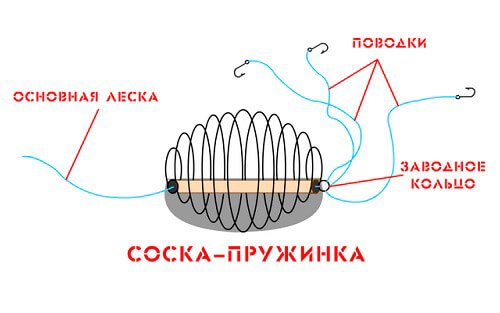
This type of gear has a feeder, the structure of which is made of a spring. This schematic solution gives confidence to the fisherman that the porridge stuffed into the feeder from the spring will not spread in the water before reaching the bottom.
The spring nipple consists of the following parts:
- Spiral feeder;
- 1 leash with fishing carabiner;
- 2-5 leashes with hooks.
Also, baits of this type are divided into 2 types:
- Loaded;
- Not loaded.
Loaded baits are equipped with lead weights and do not require their additional installation. This type of gear is convenient when fishing from the bottom.
Unloaded tackle for bottom fishing, on the contrary, requires equipping the tackle with additional weights. The convenience of this type lies in the possibility of fishing not only from the bottom.
Spring tackle can also be deaf and free-moving (sliding):
- The blind tackle is mounted directly to the main fishing line with a carabiner, which allows you to promptly replace the bait if desired.
- A free-moving or sliding bait, as it is also called, is fixed by the axial weight of the feeder on a fishing line between two stoppers. The nipple can move freely between them during the fishing process. The length of the section along which the tackle will move is determined by moving the upper stopper.
Nipple plug
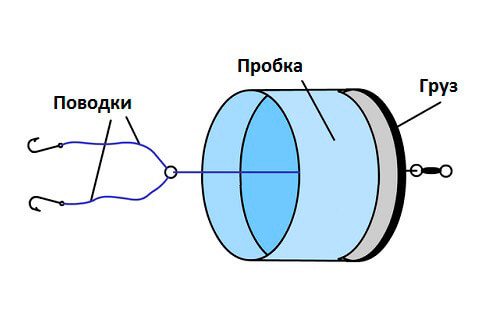
Cork is a traditional folk bait. This gear consists of:
- Feeders made of plastic bottled lids;
- Several leashes with hooks;
- Carabiner fastening;
- Lead sinker.
Let's celebrate! Like a spring nipple, the plug can be made sliding and deaf. This type of nipple has the ability to self-hook fish, which classifies it as non-sports gear.
